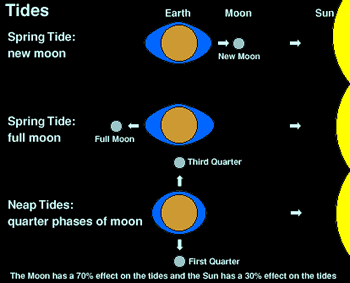You are using an out of date browser. It may not display this or other websites correctly.
You should upgrade or use an alternative browser.
You should upgrade or use an alternative browser.
the sea tides
- Thread starter cm1179
- Start date
More options
Thread starter's postsNo its not?it's pretty surreal if you think about it ...
The moon has a gravitational pull and pulls the water on earth towards it.
Sparky__H
Sparky__H
It's not just water that is pulled but it's properties means it actually has an effect.
Although you need one hell of a body of water.
Although you need one hell of a body of water.
It's pretty simple and not surreal. Water is just being pulled by the moon. Add in orbits and earth rotation and you get regular tides.
http://en.wikipedia.org/wiki/Tide
http://en.wikipedia.org/wiki/Tide
Tides are the rise and fall of sea levels caused by the combined effects of the gravitational forces exerted by the Moon and the Sun and the rotation of the Earth. The tides occur with a period of approximately 12 hours and 25 minutes, and with an amplitude that is influenced by the alignment of the sun and moon and the shape of the near-shore bottom.[1][2][3]
Most coastal areas experience two high and two low tides per day. One of these high tides is at the point on the earth which is closest to the moon. The other high tide is at the opposite point on the earth. This is because at the point right "under" the Moon (the sub-lunar point), the water is at its closest to the Moon, so it experiences stronger mavity and is raised. On the opposite side of the Earth (the antipodal point), the water is at its farthest from the moon, so it is pulled less; at this point the Earth moves more toward the Moon than the water does—causing that water to "rise" (relative to the Earth) as well. In between the sub-lunar and antipodal points, the force on the water is diagonal or transverse to the sub-lunar/antipodal axis (and always towards that axis), resulting in low tide.[4]
Soldato
- Joined
- 28 Oct 2003
- Posts
- 5,510
- Location
- Worthington-on-sea

Soldato
- Joined
- 26 Aug 2003
- Posts
- 24,290
Thing that gets me about this is that surely then the oceans are all at a bit of a slope...
So say where I live, the Estuary, when the tide's out, the water must all be squashed up to Kent and sloping towards Essex. Weird.
So say where I live, the Estuary, when the tide's out, the water must all be squashed up to Kent and sloping towards Essex. Weird.
Soldato
- Joined
- 4 Feb 2003
- Posts
- 6,134
- Location
- Birmingham
Magic.
 It's got nothing to do with Lizard Overlords or Aliens, leave him out of this. We don't want him coming in here with his mumbo jumbo
It's got nothing to do with Lizard Overlords or Aliens, leave him out of this. We don't want him coming in here with his mumbo jumbo 
Permabanned
- Joined
- 10 May 2010
- Posts
- 372
It's got nothing to do with Lizard Overlords or Aliens, leave him out of this. We don't want him coming in here with his mumbo jumbo

I think u will find that is magick not magic.
Associate
- Joined
- 23 Nov 2002
- Posts
- 2,184
- Location
- Faygate, West Sussex
Just think of it as witchcraft 

Soldato
- Joined
- 3 Aug 2008
- Posts
- 10,477
- Location
- Bath, England
last i heard it happens when all the americans go for a dip at the same time, giving high tide. then they all get out again and low tide is again upon us
Its quite simple really;
By far the most important factor, effecting the movement of water across the ocean are tides. Tides are great bulges of water, caused by the mavity of the Moon, and Sun. Attracted by mavity, these bulges move around the Earth’s oceans, causing water levels to rise and fall. Typically water will rise for about six hours, followed by six hours of falling water depths.
By far the most important factor, effecting the movement of water across the ocean are tides. Tides are great bulges of water, caused by the mavity of the Moon, and Sun. Attracted by mavity, these bulges move around the Earth’s oceans, causing water levels to rise and fall. Typically water will rise for about six hours, followed by six hours of falling water depths.
As the earth spins all the water falls to the bottomcan somoene explain it please? it's pretty surreal if you think about it ...


